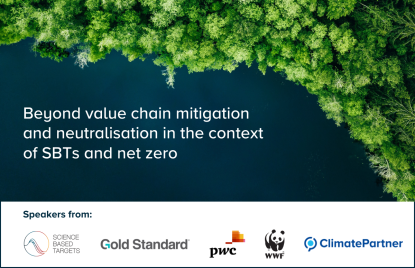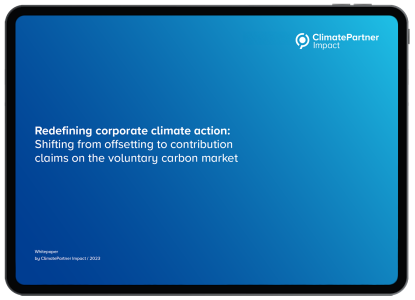Beyond value chain mitigation
The pivotal role of corporate climate action

Combatting climate change will take a united global effort. As major emitters of greenhouse gas emissions, companies are encouraged to do their part by reducing their carbon footprints and fostering sustainable practices. However, not all emissions can be avoided, and currently, we are far behind where we need to be to achieve the Paris Agreement goal of limiting global warming to 1.5 °C.
Therefore, the Science Based Targets initiative (SBTi) recommends that companies not only set emissions reduction targets, but also devote part of their budgets to beyond value chain mitigation (BVCM), funding mitigation action beyond their immediate operations. This includes financing climate projects around the world that avoid, reduce, or remove greenhouse gas emissions.
Shifting from offsetting to contribution claims on the voluntary carbon market
In the past, financing climate projects has been associated with offsetting unabated emissions in order to claim carbon neutrality. However, there is a shift within the voluntary carbon market (VCM) towards an alternative approach: contribution claims. In contrast to offsetting, making a contribution claim emphasises participation in the collective effort to achieve the overall mitigation of global emissions.
This comes with exploring new approaches, besides the now-standard practice of equating the amount of financing for climate projects with the corporate carbon footprint (the ton-for-ton approach). Alternative approaches include determining the amount of contribution to climate projects through an internal carbon price (the money-for-ton approach) or through a fixed percentage of profits or revenue (the money-for-money approach). This gives companies more flexibility in terms of the amount of funding and the specific projects supported. Contributions can, for example, provide early-stage finance to support the implementation of new certified climate projects. They can also encourage the development of new and innovative technologies or support the achievement of the UN’s Sustainable Development Goals, other than climate change mitigation.
Watch the recording of our BVCM online event
We gathered leading experts from the SBTi, Gold Standard, PwC, WWF, ClimatePartner Impact, and ClimatePartner to share their expertise and discuss how to implement BVCM and neutralisation in corporate climate action.
Fill out the form to watch the recording.

Our speakers of the BVCM online event
Learn more in our white paper
ClimatePartner Impact's white paper delves into the reasons behind the shift from offsetting to contribution claims, takes a closer look at the different approaches and highlights the benefits for companies.
Fill in the form and we will send you the white paper by e-mail.

Case study: Lidl GB and Duncan Farms
With the example of Lidl GB and its collaboration with Duncan Farms, find out what a comprehensive climate action strategy can look like and how it includes financing climate projects – globally and locally.

What is BVCM?
Understand how BVCM is defined, why it is important, and what possibilities this mechanism offers for companies.








